I would rate red mites as being one of the biggest problems you will face when keeping chickens. Red Mites live in the cracks of chicken houses (typically under perch ends) coming out at night, crawling onto your birds for a feed.
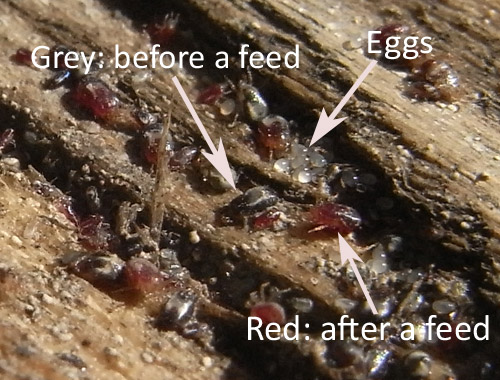
Macro shot of Red Mite in a crack on a perch. These were disturbed after a treatment with Poultry Shield.
They start off as very small greyish-white mites that swell up into red coloured mites after a feed and at their biggest are only 1mm so small numbers of them can be hard to spot unless you know what to look for.
You will often find a grey ash like deposit around perch ends which is where the mites have been and if you lift the perch, you will see clumps of mites.
Red Mite in chickens’ houses are active during the warmer months, usually May to October and will become dormant over the winter. They multiply at an incredible rate: their life cycle is just 7-10 days. In other words from hatching from an egg to being an adult laying hundreds of eggs takes just a week if conditions are right.
Be Proactive.
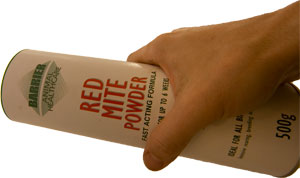 The best course of action is to check for red mite routinely when you clean your chicken house out and use some preventative treatment to the house before they get a hold. You will get to know the places to look and once you have found small numbers of them, you can treat the house to keep numbers under control. See my ‘preventative measures’ below
The best course of action is to check for red mite routinely when you clean your chicken house out and use some preventative treatment to the house before they get a hold. You will get to know the places to look and once you have found small numbers of them, you can treat the house to keep numbers under control. See my ‘preventative measures’ below
Are there Red Mite in your Chicken House?
People normally discover Red Mite when they are over-run by them. When hens are being bitten, they can refuse to go in to roost at night, they will become anaemic and their combs will go pale. They will often stop laying and you may find red blood stains on eggs (squashed Red Mites). Eventually, you will start to see losses in the flock.
Checking for Red Mite in Chickens Houses
Red Mite will hide away in the daytime but can often be seen if you lift perches, examining the ends. They will usually come swarming out if you treat the cracks with Poultry Shield but by far the easiest way to check to see if there are red mite is to take a piece of white kitchen roll and to rub it along the underside of the perch when your hens are roosting (in the dark). Look at the tissue and if there are Red Mite heading back from their feed, they will be squashed on the kitchen roll as streaks of blood.
Getting rid of Red Mite
It is very hard to get rid of them completely so it is often better to get the numbers down and then find a way of keeping them down that doesn’t involve you spending hours on cleaning the house out. There are lots of different treatments that people use, some more effective than others but I will focus on what I do and have found to be the most successful for me.
If you haven’t got red mite and the weather is warm enough for them (May to October in the UK) then skip step 1 and go straight to step 2. Preventative Measures.
1. Getting rid of an infestation.
If you find lots of red mite in the coop, it’s time for a big clean up that will take a couple of hours initially, then an hour every 5 to 7 days for at least 2 more weeks.
The products I have found to work the best (that are relatively safe) are Poultry Shield and Diatom. These two are not ‘knock down’ products as such, they do take a little while to work but are none the less very effective. I also use Red Mite Powder on the hens themselves to help them through the night when the Mites are active.
You can BUY Poultry Shield from Amazon Here.
Here is what I do with the Poultry Shield.
- Remove all birds from the house.
- Strip the house down as much as possible.
- Clean the house out – be careful where the bedding is going as red mite live for 6 months without a feed and will find a new home If they can. Ideally seal the bedding in bin bags or burn.
- Mix up as many watering cans of poultry shield mixture as is needed, as per the instructions on the label 1 part to 9 parts water.
- ‘Water’ all cracks in the chicken house, concentrating where there are perch ends and concentrations of red mite.
- Leave to soak for 15 minutes
- Red mites will be coming out. Cover them and the cracks with poultry shield again.
- Wait 15 minutes
- Hose out the house, concentrating on getting the pressure jet into the cracks and so on.
- Leave the house to dry.
Poultry Shield is a mild detergent and ‘washes’ the waxy coat off the red mites. It is also good for removing organic matter from the hen house so is useful for cleaning. I wouldn’t be without this!
After using the Poultry Shield, when the house is dry, I use Diatom. Diatom is made of micro skeletons of fossilised remains of diatoms. These were once a kind of algae found in water. They are microscopically sharp and pierce the outer waxy coating of the mites which causes them to dry out and die.
The second step also double up as my ‘preventative’ measures if you haven’t yet got a bad infestation
You can BUY Diatom from Amazon HERE
2. Preventative Measures
- Dust the ends of the perches / nest boxes and where ever else you found concentrations of red mites when cleaning.
- Rub as much into the perches as you can. Red mite will avoid the diatom and will crawl around it if they can, so make sure they have to crawl through it to get a feed.
- Repeat every couple of days for as long as you see signs of red mite in the coop.
Repeat the whole cleaning process if there are still lots of mites in 5 to 7 days. You will find you might not need to spend as long on the washing as there won’t be as many mites.
Very Important: Make sure you repeat it before 7 days so that the mites don’t have a chance to lay more eggs. A few mites become a lot in a very short space of time!
If you have a felt roof on your chicken house and they get underneath, it is usually impossible to get rid of them without removing the felt, cleaning and re-felting. My page on Chicken Houses gives more information.
Finally, I will dust the hens down between their feathers with Red Mite Powder to give them some respite during the night when the mites are active.
Beware of what you read!
There is a lot of information written about these troublesome ectoparasites on the internet these days, much of it re-written and re-spun. When I started writing about them, there was little available online. Strangely, some small errors that I had introduced on my page that I corrected in an update pop up frequently on other websites. Running a Google image search often uncovers companies that have used my copyrighted images! I make regular checks to try to stop this from happening.
If you wish to learn more about red mite then I would encourage you to read the guide to red mite on poultrykeeper.com. This is a reliable source of information and is regularly updated.

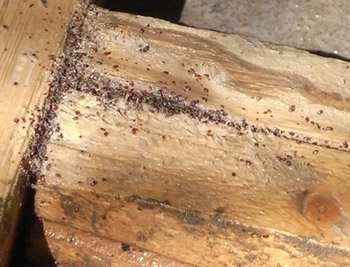
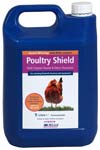
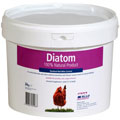
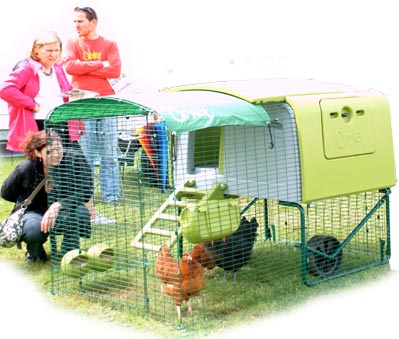
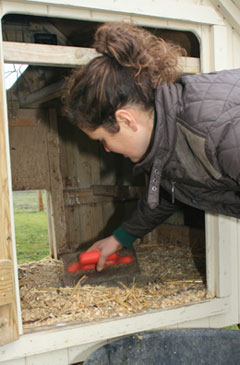
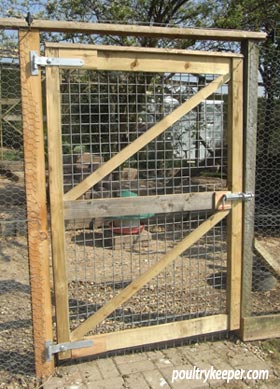
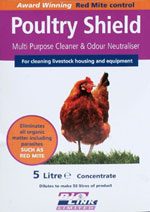
Are there any other kinds of mite? I have noticed on my hens some golden coloured mite that scuttle to the base of the feathers when exposed to the light, but none is as red as those shown in the images on the birds or inside the coop. I have dusted the birds with Red mite powder and will continue to do so as they are currently roosting on the roof and two of the three have stopped laying. Any ideas?
These are Lice, rather than mites. Ivermectin drops (available here) are what most people use but technically not licenced for chickens and you may want to withdraw eggs for a week if you use them. The other option would be something licenced that can be used on the bird like Red Mite Powder or Diatom but it will take several dustings to completely get rid of them.
Hi I am thinking of starting to keep chickens. I have a small field adjacent to my cottage so they could roam free during the day(once I fence it securely) I am having difficulty deciding upon which coop to get -wooden or plastic. The choice of wooden coops is greater (& my preference) and less costly than plastic but the thing that puts me off is Red Mite. How does the coop get infected? If you spray the coop first and also the chickens when you get them can this prevent red mite or am I just going to get them anyway? Any advice seriously wanted, also what coops are best etc….. Many Thanks
Red mite will get carried in on wild birds, clothing from other poultry keepers and sometimes on birds you buy where there is the odd mite hiding in a dark place – usually under the wings.
Remember this is a summer time problem and if you spot it early, you can keep on top of it. I usually end up with at least one bad outbreak of mites in a year in one of my coops but with regular (weekly) clean outs and inspection you usually get to see where the mites start to form before they become a problem.
I keep my perches dusted with diatom and use poultryshield when cleaning and the combination seems to keep the mites away -most- of the time. Personally, I prefer wooden coops although plastic are easier to wash out. Red mite still end up finding somewhere to breed, I’ve seen them on the bottom of a feeder or water container too and these are plastic.
Thanks for your reply. I found an item on Ebay selling for around £3.00 which says it is a Red Mite detector. You just strap it to the perch. Has anyone any experience of these or comments?? Thanks
i have a mite problem at the moment ,i have power washed,sprayed jeyes fluid,and used powder on the house and birds ..i have just lost two birds in 1 week and have noticed they are quite skinny and they were fat little buggers,,they are also pale faced and so is their crown,could this be the mites .they eat so much ,in morn spagghetti then potato peelings and there troughs are full of corn and layers pellets.the deaths are sudden after being active day before. i have just got a gas torch and i went all around the perches and edges of the coop and hope this will help.i cant think of anything else to do and dont wanna lose anymore of my girls………
dont give potatoes or potatoe peel to hens it is posionus to them
Boiled potatoes and potato peelings are fine, it’s green potatoes and the shoots / leaves of potato plants that are a problem.
Hi I am still doing research and have come across a Red Mite Fumer Used a similar thing in my greenhouse – Sulphur bomb) Has anyone any experience/advice?
I have posted a message on 22/9 about using a blow tourch, I thought I got the red mites under control but I was so wrong, everyday when I go and inspect the hen houses, there are still red mites crawling about, everyday, I feel like fighting a losing battle. It is so disheartening. However, I have good news for you all poultry keepers out there. With the warm October weather, there were lots of little flies about in the hen house, so during the day time while the chickens are out in the field scratching, I spray the hen house with LOTS of fly spray (from pound shop), shut the door, return to let the chicken back in the hen house to roost in the evening. The next day, I found hundreds of thousands of DEAD red mites near the perch. However, at the same time, I did put Diatom in the hen house, so try the fly spray to see if you get result. Good luck.